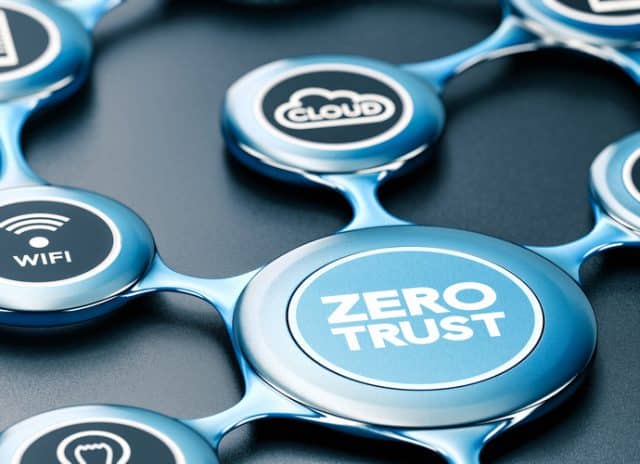Making zero trust a reality in 2023: why identity-first security will be a 'must have'

In today’s mobile and cloud-first world, zero trust has become a key requirement for organizations looking to secure the digital infrastructures where their applications, data, users and devices reside.
There’s little doubt that COVID-19 changed the rules of the game where enterprise security is concerned. Historically, security models were based on 'castle and moat' style architectures where the enterprise’s network and data center were guarded by firewalls on the perimeter. When users left the 'trusted' enterprise network, VPNs were used to extend the enterprise network to them.
However, the massive shift to remote working engendered by the pandemic meant that this perimeter-centric security approach was no longer viable. Consequently, a zero trust approach to network security quickly became established as best practice for minimizing the risk of a cyber breach.
Since then, the growing sophistication of cyber criminals combined with a need for greater architectural flexibility to support new B2B functionality means that many organizations are now evolving their approach to zero trust.
As a result, the concept of ‘identity-first security’ is rising to the fore in 2023 as organizations prioritize the initiation of authorization frameworks to determine who has access to what information, and when.
Identity: the new security perimeter
Today’s digitally dispersed work-from-anywhere realities mean zero trust has become ever more important as network perimeters expand to the point where, in practical terms, the concept of 'inside the perimeter' no longer applies.
The good news is that security professionals are able to take advantage of mature technologies that address the basic tenets of zero trust, especially around network access control and advanced authentication.
Problem is that solutions like gateway integration and segregation, secure SD-WAN and secure access service edge (SASE) are primarily focused on controlling access at the network level alone to solve or minimize the risk of a cyber breach. But implementing truly robust zero trust requires three levels of access control -- access to the network, access to applications and access to intra-application assets. Without this complete approach, true zero trust protection is difficult to achieve.
With the pressure on to secure their digital assets and interactions, a growing number of security leaders are now coming to the realization that it’s time to evolve their zero trust architectures and prioritize the implementation of identity-first security regimes. Ensuring that identities and their access are verified and controlled on all levels of the organization’s technology stack, including access points, networks, applications, services, APIs, data and infrastructure.
By doing so, they will be able to resolve the problem of what happens when cyber criminals utilize credentials obtained through phishing or brute force to breach the network and move laterally to access systems or data.
Identity-first security: what is it, and what's driving adoption?
Digital commerce and remote work demands have created new opportunities and security risk vulnerabilities. As a result, the digital workforce and consumers require more access to digital assets from multiple devices, sources and locations.
To secure these digital interactions, organizations need to ensure that an individual is authorized throughout their digital user journey and granted the right level of access to appropriate digital assets. Regardless of whether access is undertaken via the cloud or on-premises.
Accordingly, IAM (Identity and Access Management) is having a moment in the sun as enterprises look to initiate advanced data access controls that will secure and protect digital assets while minimizing friction during a user’s digital journey.
This in turn is driving the re-emergence and relevance of authorization, which has been a foundational component of IAM platforms for decades. As recognition grows that more needs to be done to ensure secure user journeys, demand is growing for advanced authorization frameworks that make it possible to secure data at key access points such as API gateways, applications, microservices and data lakes. So that users get to enjoy the most secure and user friendly experiences.
What’s next for identity-based security?
The growing need to work and collaborate with data is spurring organizations to consolidate data in cloud data hubs that will add further complexity to the current security challenge.
As the costs associated with a data breach continue to escalate, authorization-related initiatives such as run-time access, API access control and policy-based access control (PBAC) are all becoming top IAM priorities for organizations looking to ensure that appropriate -versus unlimited -- access is granted only to trusted user identities in a dynamic and real-time manner.
While role and attribute-based access control (RBAC and ABAC) offer organizations competent methodologies for policy creation, PBAC is fast emerging as the most effective authorization policy creation and management approach. Offering a user-friendly GUI for constructing policy logic that eliminates any need for technical and coding expertise, PBAC makes authorization manageable for everyone, including business owners and data analysts.
Indications are that in 2023 access control policies will become the preferred method for controlling access. Indeed, an increasing number of technology and cloud vendors now offer a policy option in addition to the entitlement and role-based methods that have, until now, traditionally held sway. This represents a very positive step forward with regard to simplifying this challenging technology space.
Staying one step ahead of cyber threats in 2023
In an era where the tactics and technologies employed by bad actors are becoming ever more challenging to address with legacy security solutions, zero trust offers a robust approach to reducing the risk and damage posed by a security breach.
However, in an era that’s increasingly characterized by cloud-based collaboration, exploding data growth and work-from-anywhere environments, identity-first security underpinned by advanced access and authorization controls will prove critical for protecting people, networks and data.
In 2023, security leaders that want to be fully confident in the completeness of their zero trust frameworks are prioritizing the implementation of advanced data access controls that are identity aware, dynamic, fine-grained and governed by policies.
Image credit: Olivier26/depositphotos.com
Gal Helemski is CTO and Co-founder of PlainID.
